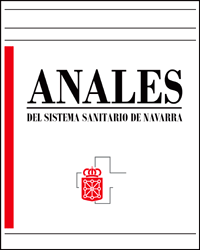Epidemiological profile of patients infected by Human Immunodeficiency Virus (HIV)
DOI:
https://doi.org/10.23938/ASSN.0692Keywords:
HIV, Perfil epidemiológico, Grupos de riesgo.Abstract
Introduction. The aim of the present work is to identify the principal characteristics of a sample of individuals at the moment of diagnosis of HIV infection. Material and methods. Descriptive, retrospective study, based on the hospital clinical records of 70 HIV+ patients, without AIDS, selected by means of simple aleatory sampling. Results. Transmission categories: Users of Injectable Drugs (UID) 81.4%, heterosexuals 10%, homo/bisexuals 4.3% and transfusions/plasma donors 2.9%, sex: ratio man/woman = 3.8/1, average age on diagnosis: 27.3 ± 7.0 years (UID 26.3 ± 5.1 years, heterosexuals 29.6 ± 2.1 years, homo/bisexuals 27.3 ± 3.9 and transfusions/plasma donors 51.4 ± 23.1 years (p = 0.02). Heterosexual transmission amongst women was 18.8% against 7.4% in men (2.5:1). Marital status: single in 66.7% of the cases. Working activity: 48.9% without work, outstanding amongst those with work was the relatively high proportion of HIV+ working in the building trade (29.2%). Smoking habit: 91.8% were smokers, with greater incidence amongst the UID (100%). Clinical situation: during the five years of follow up, 49% of the patients developed AIDS, with cachectic syndrome because of HIV being the first disease indicative of AIDS at the time of its appearance in the majority of the cases (36.7%) in this sample. The average interval between the date of diagnosis of HIV infection and diagnosis of AIDS was 44 months (rank: 0.9-131). Conclusions. HIV infection in our sample appears mainly in individuals who are young, male, UID, unemployed and smokers. Prevention strategies should be directed at women, at individuals with a higher risk of heterosexual transmission and at youths who are unemployed or low skilled.Downloads
Downloads
Published
How to Cite
Issue
Section
License
La revista Anales del Sistema Sanitario de Navarra es publicada por el Departamento de Salud del Gobierno de Navarra (España), quien conserva los derechos patrimoniales (copyright ) sobre el artículo publicado y favorece y permite la difusión del mismo bajo licencia Creative Commons Reconocimiento-CompartirIgual 4.0 Internacional (CC BY-SA 4.0). Esta licencia permite copiar, usar, difundir, transmitir y exponer públicamente el artículo, siempre que siempre que se cite la autoría y la publicación inicial en Anales del Sistema Sanitario de Navarra, y se distinga la existencia de esta licencia de uso.








